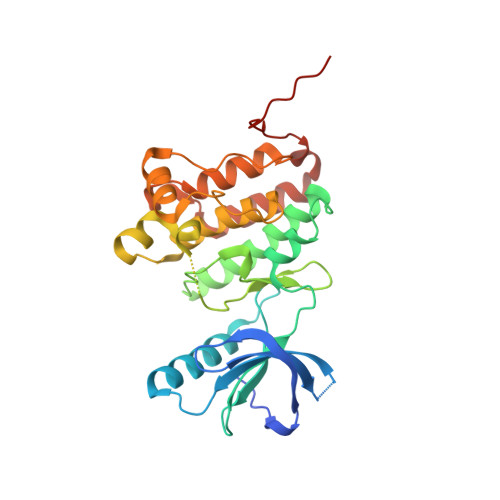Optimization of the Lead Compound NVP-BHG712 as a Colorectal Cancer Inhibitor.
Troster, A., DiPrima, M., Jores, N., Kudlinzki, D., Sreeramulu, S., Gande, S.L., Linhard, V., Ludig, D., Schug, A., Saxena, K., Reinecke, M., Heinzlmeir, S., Leisegang, M.S., Wollenhaupt, J., Lennartz, F., Weiss, M.S., Kuster, B., Tosato, G., Schwalbe, H.(2023) Chemistry 29: e202203967-e202203967
- PubMed: 36799129
- DOI: https://doi.org/10.1002/chem.202203967
- Primary Citation of Related Structures:
8BOC, 8BOD, 8BOF, 8BOG, 8BOH, 8BOI, 8BOK, 8BOM - PubMed Abstract:
The ephrin type-A receptor 2 (EPHA2) kinase belongs to the largest family of receptor tyrosine kinases. There are several indications of an involvement of EPHA2 in the development of infectious diseases and cancer. Despite pharmacological potential, EPHA2 is an under-examined target protein. In this study, we synthesized a series of derivatives of the inhibitor NVP-BHG712 and triazine-based compounds. These compounds were evaluated to determine their potential as kinase inhibitors of EPHA2, including elucidation of their binding mode (X-ray crystallography), affinity (microscale thermophoresis), and selectivity (Kinobeads assay). Eight inhibitors showed affinities in the low-nanomolar regime (K D <10 nM). Testing in up to seven colon cancer cell lines that express EPHA2 reveals that several derivatives feature promising effects for the control of human colon carcinoma. Thus, we have developed a set of powerful tool compounds for fundamental new research on the interplay of EPH receptors in a cellular context.
Organizational Affiliation:
Center for Biomolecular Magnetic Resonance Institute for Organic Chemistry and Chemical Biology, Johann Wolfgang Goethe University, Max-von-Laue-Straße 7, 60438, Frankfurt am Main, Germany.















